| June
26, 2007
Hello from Toronto: Exploring Toronto with
Sights on Bikes
For a person as curious as me, I am always out on some sort of
discovery. No wonder travel writing appeals so much to me because
it gives me the opportunity to explore interesting new places all
the time. But of course my inquisitive mind never rests, so when
I am not traveling out of town, I venture out locally right here
in my chosen home town of Toronto to investigate the nooks and crannies
of my city.
Over the last few years I have had an opportunity to explore many
different cities in many different ways, by walking, through driving
tours, sightseeing buses, architectural tours, even boat tours or
by taking public transit; but one of my very favourite ways is to
discover a city by bicycle. With a bike you can get almost anywhere,
you cover more ground than by walking, but you are still able to
stop at any time and admire a particular detail up close. In addition,
it helps you burn a few calories, a consideration that is becoming
ever more important as my waistline expands.
So I had already done bicycle tours in Montreal
and Vancouver,
and I was wondering if there was a company in Toronto that offered
organized bicycle tours. On the website of my good friend Bruce
Bell, a renowned Toronto historian and tour guide, I finally
found a link to a company called “Sights
on Bikes”. That sounded interesting, so I started investigating
their website and contacted one of the co-owners, Jordan Feilders,
to tell me more about his company. He suggested that I come out
to Sights on Bikes Deluxe City Tour to experience Toronto first-hand
in one of his organized bicycle tours.

Jordan Feilders from Sights on Bikes gets ready for the tour
Punctually at 10 am I was waiting at the southwest corner of the
intersection of Yonge Street and Queens Quay. Another lady dressed
in bicycle attire came up to me and asked me if I was about to participate
in the bicycle tour. I confirmed and she introduced herself as Susan
from Florida who was up here in Toronto to join her husband who
was here to attend a conference. Just minutes later our tour guide
Jordan arrived and welcomed us.
Ever nosy I asked him to tell me a bit about his background and
he indicated that he is a graduate of the University of Toronto
in International Relations and Environmental Studies. Three years
ago he started Sights
on Bikes together with two friends, initially as an idea for
a cool summer job during university. Since then Jordan has taught
skiing in Jackson Hole and also worked during the winter at a lobby
firm in Washington, D.C. In the summer he returned to Toronto to
run his company and he is on the road with visitors virtually every
day.
Jordan took us to a locked storage container on the parking lot
and retrieved three bicycles as well as helmets for us. Sights on
Bikes’ bicycles are extremely comfortable touring bikes with
six gears that make sight-seeing an easy and painless experience.
We started cycling up Yonge Street and then turned east on the Esplanade,
one of Toronto’s premier restaurant streets that at one point
actually used to be at the waterfront of Toronto before the harbour
area to the south was filled in.
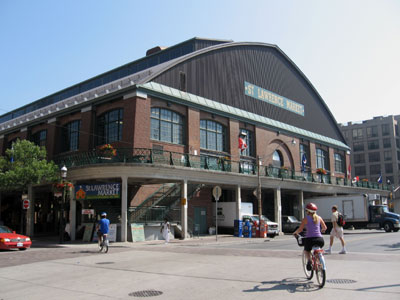
The south side of the St. Lawrence Market
Our next stop was the St.
Lawrence Market, one of two major markets in Toronto. This market
was actually Toronto’s first permanent city hall and jail
house between 1845 and 1899. A police station also used to be located
on the first floor. In the late 1800s the market building was altered
radically after the construction of Toronto’s City Hall at
Queen and Bay Streets. The central portion of the original market
building (the South Building) has survived and the original council
chamber of the former city hall today houses the Market Gallery.
Susan and I had a quick peek into the market hall and admired the
wide assortment of food retailers.
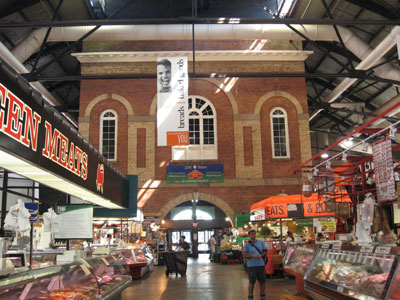
The market hall at the St. Lawrence Market
The St. Lawrence Market is one of Toronto’s beloved historic
buildings, and the lively atmosphere of the market and the extensive
culinary assortment is a huge draw for locals and tourists alike.
The market features everything from baked goods, cheese and dairy
products, to flowers, fruits, vegetables, meats, poultry and seafood
to organic products and gourmet teas and coffees. Several sit-down
restaurants and snack-bars will soothe hungry appetites. The North
Market across the street features a farmer’s market on Saturdays
and an antique market on other days.
The area at the foot of Jarvis and Front Street also used to be
the terminus of the Underground Railway, a network of secret routes
and safe houses that allowed African slaves to escape from the southern
United States to free states and Canada. It is estimated that a
least 30,000 slaves escaped to Canada, and many of these slaves
arrived on boats in Toronto at the foot of Jarvis Street.
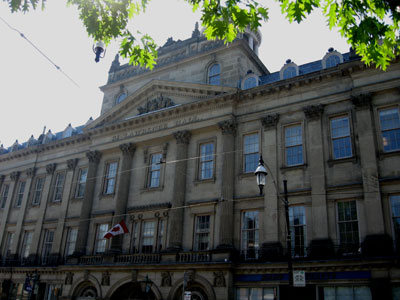
St. Lawrence Hall
Just one block north of the St. Lawrence Market Jordan made another
stop and briefed us on another historic jewel of Toronto: St. Lawrence
Hall, located at the intersection of King and Jarvis Streets, was
constructed from 1849 to 1850. Originally this structure contained
a hall for public meetings on the north side, and a covered market
on the south. During its heyday it was used for important social
and cultural events as well as lectures. After many years of disrepair
it was finally restored to its former glory in 1967 and has again
become a location for special events in the city.
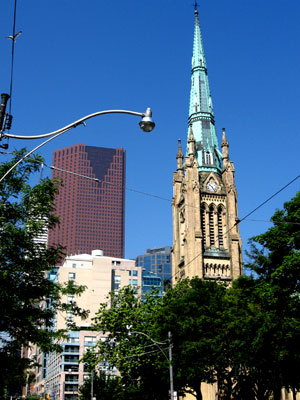
The spire of St. James Cathedral
Right across the street Jordan
took us to our next destination: St. James Cathedral, the oldest
congregation in Toronto. First established in 1797, the current
cathedral was completed in 1844 and with a height of 305 feet it
features the second tallest church spire in Canada (after St. Joseph’s
Oratory in Montreal). One of the most colourful personalities connected
to this Gothic Revival church was the Right Reverend Dr. John Strachan,
the first Anglican Bishop of Toronto. He was a member of Canada’s
“Family Compact”, the conservative elite that first
ruled the British colony of Upper Canada. He was known for his fierce
loyalty to the British monarchy, as well as his hatred for slavery
and republicanism. The cathedral itself has received heritage designations
from the Ontario Ministry of Culture, from Heritage Toronto as well
as from the Government of Canada.
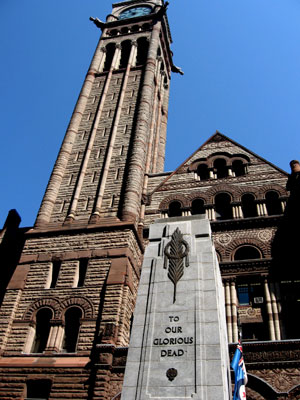
Old City Hall
We followed Jordan up Church Street, and then turned west on Richmond
Street to turn north on Bay Street where we made our next stop at
Toronto’s Old City Hall. It was built between 1889 and 1899
and designed by famous architect E.J. Lennox who also designed Toronto’s
Casa Loma and the King Edward Hotel. Old City Hall is a masterpiece
of Richardson Romanesque Revival style with rich carvings adorning
the façade. The original budget of $600,000 had grown to
more than $2.5 million which caused a major uproar on Toronto’s
city council. The clock tower is more than 300 feet (over 100 m)
high and features a gigantic bell known as Big Ben. At the time
of its completion Old City Hall was the largest building in Toronto
as well as the largest civic building in all of North America. Old
City Hall was almost demolished in the 1960s but a group of concerned
citizens fought to save it, and today it is a National Historic
Site.
Jordan not only filled us in on the various sights along the way,
he also gave us a civics lesson and explained the Canadian flag,
the Canadian parliamentary system, the Canadian healthcare system
as well as Canada’s history and the origins of Quebec and
Ontario. This type of knowledge is particularly important to out-of-towners
who are trying to understand this city and my co-traveller from
Florida certainly appreciated this information.
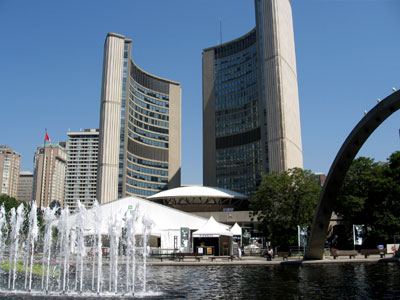
New City Hall
Across the street we stopped at the next site: Toronto’s
New City Hall, one of Toronto’s most distinctive landmarks.
The building was opened in 1965 and was designed to replace Old
City Hall. The architect for this modernist design was chosen in
an international competition in 1958 and the winning entry among
more than 500 designs was by Finnish architect Viljo Revell. New
City Hall is composed of two rounded towers on a rectangular base
that features a saucer-like council chamber. In front of New City
Hall is Nathan Phillips Square, an expansive public space that is
often used for festivals and special events and features a reflecting
pond in the summer that is turned into a popular skating rink in
the winter.
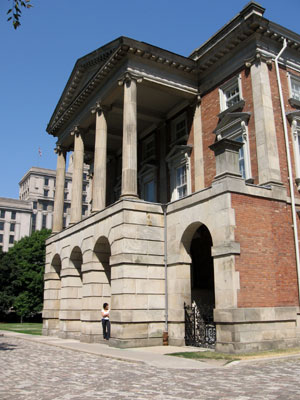
Osgoode Hall
Then Jordan took us to our next stop: Osgoode Hall, a landmark
building just west of New City Hall that houses the Ontario Court
of Appeal, the Superior Court of Justice as well as the headquarters
of the Law Society of Upper Canada. The original building was constructed
between 1829 and 1832 and was named after William Osgoode, the first
Chief Justice of Upper Canada. Further expansions happened in the
second half of the 19th century. The cast iron gates surrounding
the property feature so-called “cow gates” which were
intended to keep out grazing cows which were still a frequent sight
in the young City of Toronto.
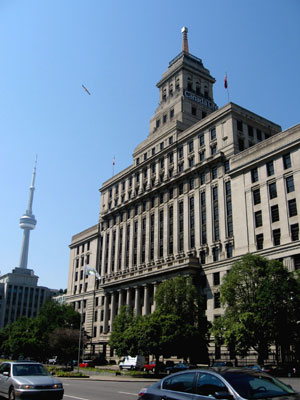
The Canada Life Building
Just southwest of Osgoode Hall is the Four Seasons Centre for the
Performing Arts, a 2000+ seat theatre that opened in June of 2006.
We turned right and headed north on University Avenue, a six-lane
divided principal arterial road and Toronto’s widest avenue.
One of the main landmarks on University Avenue, the fifteen-storey
Canada Life Building, built in Beaux Arts style, was completed in
1929 and was one of the tallest buildings in Toronto at the time.
This building is famous for its weather beacon which has been announcing
the weather in the city since 1951. Steady green indicates fair
weather, red means rain, white means snow, and lights moving up
or down indicate a temperature change. Jordan also pointed out the
American Consulate which is occasionally a location of protests
when various groups voice their opinions against US policy. Further
north, University Avenue is dominated by a series of hospitals.
The street then splits into the eastern and western half of Queen’s
Park Circle, whose centre is dominated by Queen’s Park, another
imposing Richardsonian Romanesque Revival structure and the seat
of the Ontario legislature.
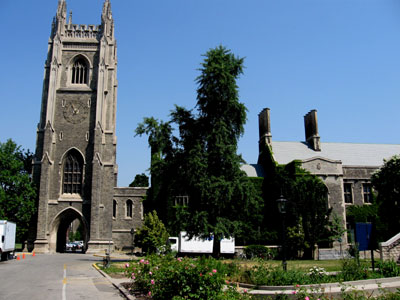
Hart House with the Soldier's Tower
Our next stop was the University of Toronto Campus, headquarters
of Canada’s largest university (with close to 60,000 students)
and one of its oldest, chartered in 1827. U of T is consistently
ranked as one of the top 30 university in global rankings. We admired
historic buildings such as the Soldier’s Tower completed in
1924 to commemorate members of the U of T community who fell during
the war; University College with its mix of architectural styles
– a National Historic Site which was built between 1856 and
1859; Knox College built in Collegiate Gothic style and opened in
1915; as well as Convocation Hall, a round building modeled after
the Sorbonne theatre in Paris and opened in 1907.
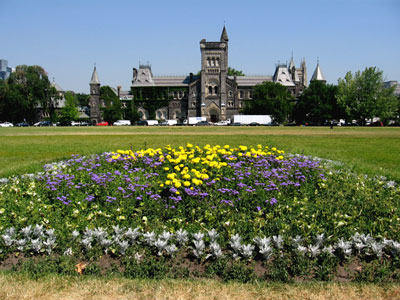
University College - a national historic site
Jordan’s tour then took us west on College Street to the
Kensington Market
area, one of Toronto’s most colourful and diverse neighbourhoods.
Traditionally home to successive waves of immigrants, the Kensington
Market area is a hustling and bustling area full of edgy clothing
retailers, bakeries, ethnic grocery shops, funky stores and restaurants.
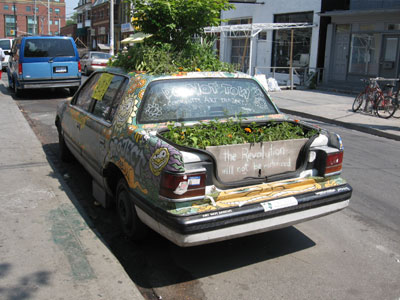
Creative community art in Kensington: "Do not tow - community
art project"
Jordan took us to the “Urban Herbivore”, a restaurant
that serves fabulous soups and other vegetarian delights. I enjoyed
a scrumptious sweet potato soup and a sweet potato muffin. After
our short break Jordan led us onto Spadina Avenue, the centre of
Toronto’s largest and oldest Chinatown (Toronto has three
different Chinatowns within its city limits).
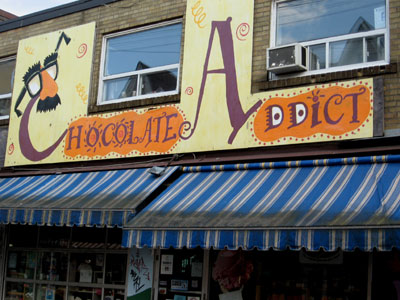
Funky stores in Kensington Market
Both today’s Chinatown
and Kensington Market area were originally settled by Jewish
immigrants from Eastern Europe. Later waves of immigration and the
northward migration of Jewish residents have made Kensington a very
diverse and ethnically mixed neighbourhood that today features many
Latin American and various Asian stores and residents. Toronto’s
Chinese area was originally located near Queen and Bay Streets,
but with the construction of New City Hall and Nathan Phillips Square
the Chinese community moved westwards to Spadina. Lower Spadina
is also the heart of Toronto’s Fashion District, which even
today features many garment factories.
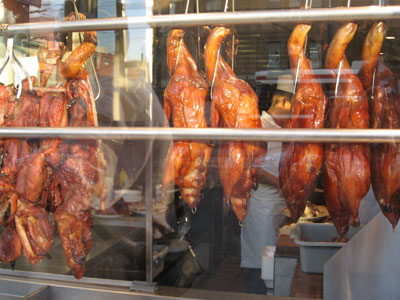
Roasted ducks in Chinatown
After the hustle and bustle on busy Spadina Avenue, Jordan led
us east towards Peter Street which turns into Blue Jays Way and
took us right past the Rogers Centre, the former Skydome, Toronto’s
multipurpose stadium with the retractable roof. Right at the intersection
of Blue Jays Way and Navy Wharf Court there is an imposing monument,
the Memorial to commemorate the Chinese Railway Workers in Canada.
Jordan stopped to explain the history behind this impressive monument.
A wooden railroad trestle with two precariously perched railroad
workers illustrates the hard and dangerous work of Chinese workers
who built the Canadian Pacific Railroad through the Rocky Mountains
in the 19th century. More than 4000 workers were killed in construction-related
accidents between 1880 and 1885.
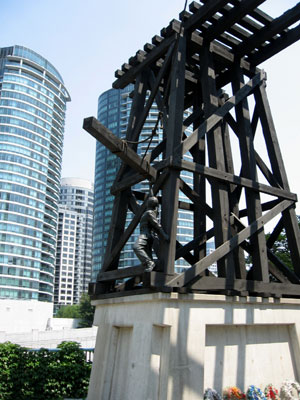
The Memorial to the Chinese Railroad Workers
We then cycled past the Rogers Centre on Bremner Boulevard to Roundhouse
Park, the green space right next to the CN Tower that features one
of the most impressive views of downtown Toronto’s skyscrapers.
The former John Street Roundhouse was originally built by the Canadian
Pacific Railway in 1929 to service and repair locomotives; today
it features the popular Steam Whistle Brewery.
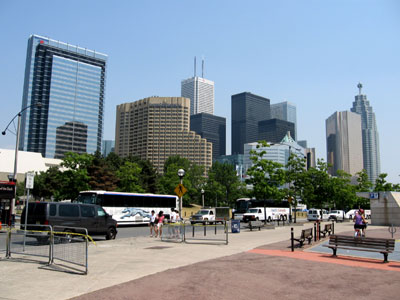
View of downtown skyscrapers from Roundhouse Park
Jordan then took us underneath the elevated Gardiner Expressway
to Harbourfront, a popular entertainment district right on Lake
Ontario. Harbourfront Centre features a variety of shopping and
dining facilities; there are art galleries, visual arts and exhibition
spaces, theatres, concert facilities and an International Marketplace
that entices with food and merchandise from all over the world.
The nearby Toronto Music Garden is a delightful green space designed
by internationally renowned cellist Yo Yo Ma and landscape designer
Julie Moir Messervy. In the winter Canada’s largest artificially
cooled outdoor ice rink entertains the crowds.
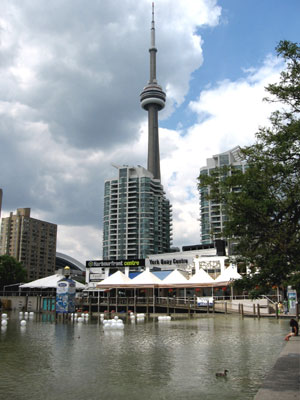
Harbourfront Centre with the CN Tower
Jordan had already taken us on a very action-packed tour through
the city, but the real gem was still waiting for us: a visit to
the Toronto Islands. The price of the ferry ride at the foot of
Bay Street was already included in the tour price. Although I have
been over on the islands numerous times, the ferry ride with its
beautiful panoramic vistas of Toronto’s skyline and the arrival
on the serene islands are always a real treat. For Susan, the tour
participant from Florida, the experience must have been even more
special. All of a sudden Toronto’s concrete roads and skyscrapers
receded and we landed in the quiet, peaceful and car-free paradise
of the islands that offer the perfect view of this hyper-active
bustling metropolis. Definitely worth the price of admission…
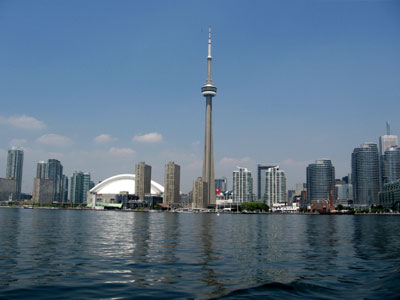
A look back from the ferry
Having landed at Hanlan’s point, Jordan, our expert tour
guide from Sights
on Bikes, first took us to a statue of Ned Hanlan (1855 to 1908),
a fisherman, hotelkeeper and later championship rower, five time
consecutive world champion between 1880 and 1884 in single-scull
rowing, who only lost six of his 300 races during his rowing career.
Just steps away Jordan pointed out to us the location of Babe Ruth’s
first professional home run in 1914. Although the stadium was demolished
in 1937, a plaque still remembers this historic event.
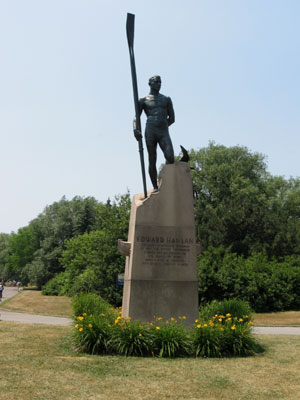
Ned Hanlan, championship oarsman
We cycled past the nearby “clothing optional” beaches
to stop at the Gibraltar Point Light House, a historic building
dating back to 1808 that is the setting for a well-known ghost story.
Jordan explained that one of the lightkeepers who disappeared and
whose murdered body was later found is still said to haunt this
area. Further east we stopped at the reflecting pools and the pier
that projects southwards from the islands. A snack bar provides
welcome refreshments and a bicycle rental booth is located here
which also features two-seater quadricycles.

The haunted Gibraltar Point Light House
At some point the Toronto Islands were densely populated and featured
a variety of grand hotels, retail stores, residential areas, various
amusement parks and restaurants. Today only the Centreville Amusement
Park remains as well as 62 homes which are mostly located in the
eastern section of the islands in Ward’s Island and Algonquin
Island.
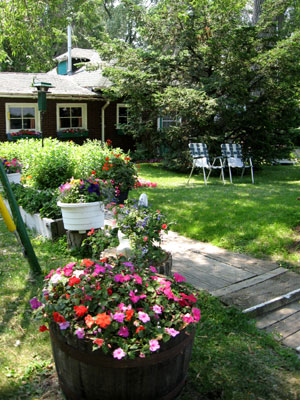
One of the quaint cottages on Ward's Island
Resident lease them in 99 year lease agreements, and strict rules
apply to the buying and selling of island homes. Many of the houses
are still quaint cottages although some have been expanded while
others display some signs of neglect. We stopped at a special spot
from where we had a perfect view of downtown Toronto’s skyline.
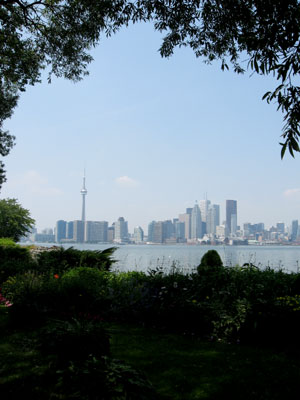
Toronto skyline, viewed from the island
Our deluxe city tour had almost come to an end. Jordan took us
past the Centreville Amusement Park with its Swan Pond back to the
Centre Island ferry and 20 minutes later we reached the mainland.
Our biking adventure ended in front of the Captain John floating
seafood restaurant where we said goodbye to Jordan and thanked him
for guiding us so expertly through some of Toronto’s most
interesting areas. Although I know the city quite well, I found
this tour
really worthwhile since I learned so many new things about my chosen
home town.
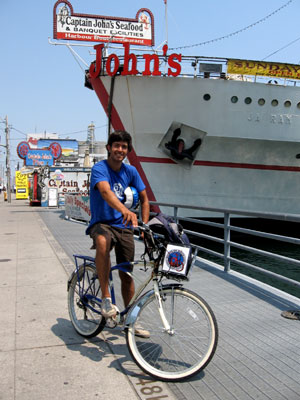
Jordan in front of Captain John's: a job well done...
Useful Books:
Related Articles:
Exploring Casa
Loma: Sir Henry Pellatt - a fascinating chapter of Toronto's history
Personal explorations
of the nooks and crannies of Casa Loma
A behind-the-scenes
look at the Royal York Hotel
Detailed explorations
of Toronto's distillery district
Toronto sizzles
in the summer
The Toronto International
Dragonboat Festival 2006
Summerlicious
2006: Toronto's restaurant festival
Toronto's
Taste of Little Italy: free food, great music and vibrant street
life
The 2006
Toronto Street Festival and Afrofest
A cross-city cycling
tour, Salsa on St. Clair and multiple free concerts
A walking tour
of Chinatown and Kensington
Cycling through
the Don Valley & the Distillery District to the Toronto Islands
|